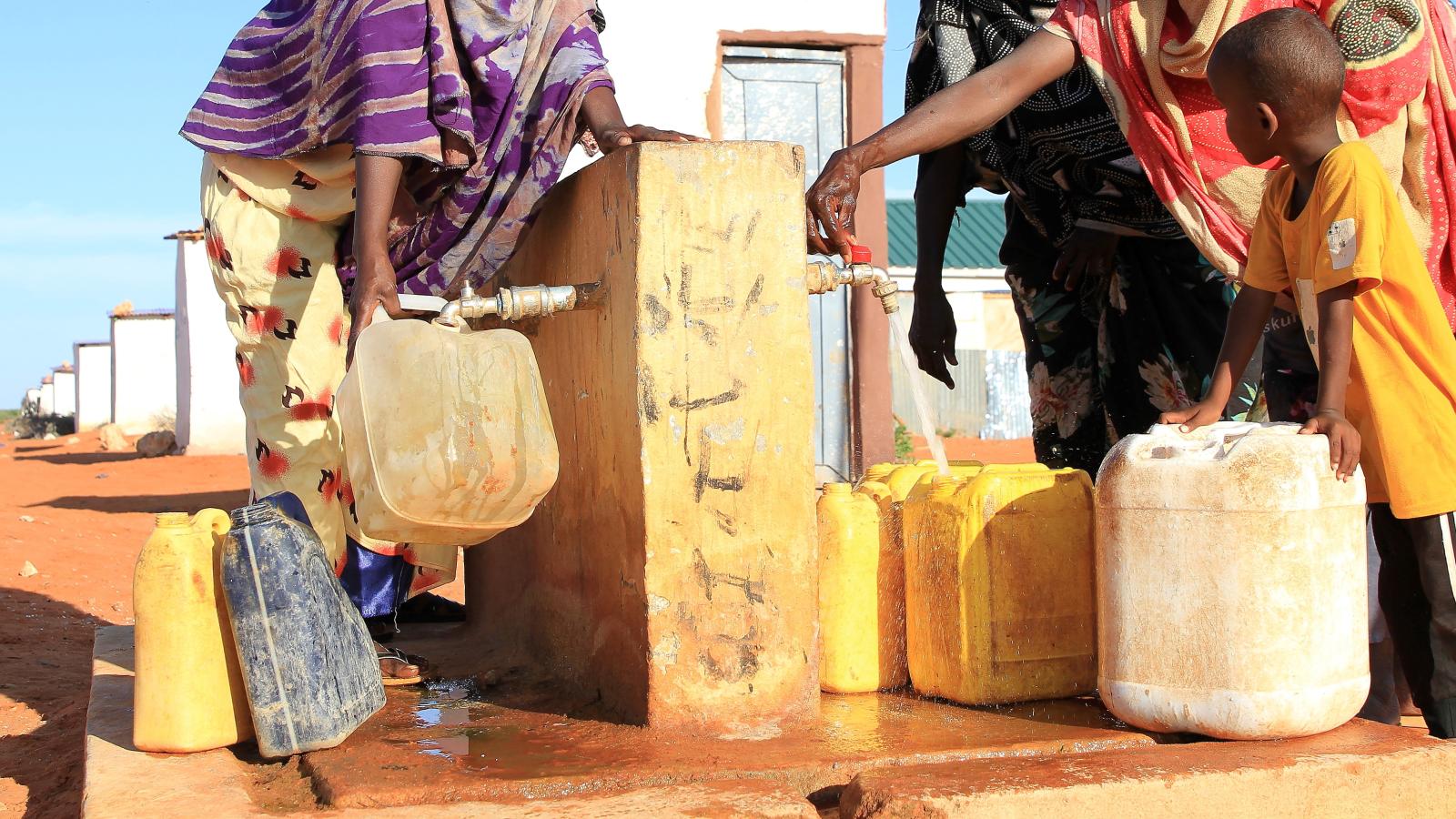
Response overview
Populations in Somalia continue to be affected by climatic shocks and insecurity, often leading to their displacement. Urban areas receive newly displaced people, who move into private IDP sites with poor living standards, a lack of tenured security, and inadequate access to basic services. Local integration and IDP returns are also limited, as many displaced families have lost livelihoods and are continually reliant on humanitarian services. Those displaced to informal sites, in particular, are living in precarious conditions and are not having their basic needs met due to inconsistent service provision, barriers to or exclusion from accessing humanitarian support.
- Strengthen inclusive community self-management and access to information for displaced populations
- Strengthen safe and equitable access to multi sectorial services at site level through improved site management and coordination
- Improve living conditions of displaced people through site development, care and maintenance and decongestion initiatives
- Support opportunities for displaced people to achieve durable solutions
CCCM Mecanisms in Somalia
The cluster targets 600,000 newly displaced persons and 1.8 million in protracted displacement, out of which 26,000 IDPs are from rural areas; the definition of ‘rural’ was established in consultation with IDMC and the IDP Working Group. Based on the analysis there are 229 rural IDP sites . The cluster objectives seek to strengthen safe access to multisectoral services through effective site management and coordination of services while focusing on improving living conditions of displaced people through risk identification, site maintenance and decongestion initiatives. The cluster will also strengthen community self-management enhancing community engagement and accountability, information awareness and supporting opportunities for displaced people to achieve durable solutions. These objectives will contribute to the HRP strategic and specific objectives of preventing loss of life, building resilience and addressing protection risks faced by IDPs including persons with disabilities, women, children, minorities and other vulnerable groups.
To support IDPs across Somalia, the CCCM cluster seeks to enhance the area-based approach for coordination through its sub-national mechanisms. At both national and sub-national level, the cluster will apply multi-cluster and inter-cluster approaches to lead the coordination of CCCM interventions and activities in IDP sites. The cluster will map and monitor services, identify service gaps, capture trends and provide evidence-based data analysis for its own operation as well as inter-cluster and local authority-led responses. CCCM minimum response activities will be integrated into the IRF ensuring orientation of new arrivals and protracted IDP on; services availability, messaging on “free of charge” nature of services, providing emergency contact, conduction awareness on services referral pathways and registration of new arrival IDPs entering CCCM managed sites within 48 hours. Following the December 2022 HCT recommendation on “standardizing CCCM Registration: CCCM Cluster (IOM, UNHCR) harmonizing registration systems through KoBo to facilitate speedy provision of assistance to the affected people.” CCCM will enhance the New Arrival Tracker to include systemized enrollment of new arrival IDPs entering CCCM managed sites with the aim of standardized registration forms in IDP sites mitigating duplication and improving efficiencies. Registered household data will be provided to the immediate response cluster and partner upon formal request for this information.
In 2023, the CCCM cluster will target sites across 44 districts where it has a partner presence. This will help to increase the CCCM coverage to 60%. The sub-national cluster teams that include a roving coordinator will provide operational support to partners, while the national cluster team of coordinators and information management specialists will provide coordination services and technical guidance for CCCM interventions. This will support better information analysis and information products that will enable partners and sub-national cluster teams to better identify service gaps in IDP sites for a multisectoral response. The cluster will also build upon data collected through new arrivals in IDP sites to gather some of the constraints in areas of origin causing displacements. This will facilitate advocacy for assistance to be provided in those areas to mitigate or reduce the displacement cycle.
The cluster will require $65.9 million to provide essential support to 2,456,143 people in IDP sites. The response cost utilizes an average cost of $27 per person as analyzed based on the 2021/22 programming data. Primary cost drivers for CCCM activities are site improvement and decongestion activities which involve the procurement of toolkits and equipment necessary for site maintenance, working with communities in clearing drainages to mitigate flooding risk and other community works such as cleaning campaigns to improve public hygiene. These activities are conducted through the Cash for Work (CfW) modality, which has proven essential and lifesaving, particularly for women, youth, minority and persons with disabilities who reported spending cash to improve their living standards such as buying water, food and other basic household items. Construction of CCCM community structures such as community and information centres, erection of solar lights and information boards are part of the large infrastructure primary cost. Furthermore, critical capacity building, partner-led workshops, community engagement and awareness raising as well as maintaining CFM system are cost drivers for CCCM operations.
The cluster has developed various monitoring tools and intercluster indicators to track the progress of its activities. This is to ensure services are provided at site level in accordance with the minimum SPHERE standards. The cluster also provides a monthly analysis of various intersectoral service gaps to support the improvement of service standards. In addition to the cluster monthly site monitoring tool, activities such as service mapping, site-level CFMs and annual safety audits will monitor and evaluate progress against the established indicators. Various assessments such as the Detailed Site Assessment (DSA), bi-annual site verifications, annual rapid gender assessments, and annual satisfaction surveys will contribute to analysing the response. The site prioritisation matrix developed through the DSA enables the identification of sites with extreme needs which, in turn, supports the cluster in advocating for service delivery in those locations. Tools such as satisfaction surveys enable affected communities to directly report on cluster performance, while the site verification assessment collects disaggregated data based on age, gender and diversity to inform response planning.
Contacts
Olivia Mocanasu
[email protected]
Charis Galaraga
[email protected]
Hassan Yarow
[email protected]
Oscar Gitonga
[email protected]
Sujan PAUDEL
[email protected]
Somalia Dashboards
FROM HUMANITARIANRESPONSE.INFO
FROM RELIEFWEB.ORG
HDX DATASETS
21 Common Operating Datasets or CCCM-tagged datsets are on the Humanitarian Data Exchange:
-
Somalia - Internal Displacements Updates (IDU) (event data) - IDMC - [2025-05-08T00:00:00 TO 2025-11-04T23:59:59]
-
HDX HAPI Data for Somalia - Armed Conflict Location & Event Data Project (ACLED), INFORM, Integrated Food Security Phase Classification (IPC), International Organization for Migration (IOM), OCHA Financial Tracking System (FTS), OCHA Humanitarian Programme Cycle Tools (HPC Tools), OCHA Somalia, UNHCR - The UN Refugee Agency, WFP - World Food Programme - [1997-01-01T00:00:00 TO 2028-12-31T23:59:59]
-
Somalia IOM Displacement Tracking Matrix (DTM) from API - International Organization for Migration (IOM) - [2016-06-01T00:00:00 TO 2024-09-30T23:59:59]
-
Global IOM Displacement Tracking Matrix (DTM) from API - International Organization for Migration (IOM) - [2010-06-30T00:00:00 TO 2025-09-30T23:59:59]
-
Somalia Flood and Drought Dashboard - Multiple source - [2020-06-30T00:00:00 TO 2020-06-30T23:59:59]
-
Future Displacement Forecasts - Danish Refugee Council - [2025-01-01T00:00:00 TO 2027-12-31T23:59:59]
-
Somalia - Internal Displacements (New Displacements) – IDPs - IDMC - [2008-01-01T00:00:00 TO 2024-12-31T23:59:59]
-
Somalia CCCM IDP Site Master List - CCCM Cluster Somalia - [2024-04-01T00:00:00 TO 2024-12-31T23:59:59]
-
Somalia Displacement - [IDPs, Returnees] - Baseline Assessment [IOM DTM] - International Organization for Migration (IOM) - [2020-02-01T00:00:00 TO 2024-09-19T23:59:59]
-
CCCM Cluster Somalia: Complaints and Feedback Mechanism (CFM) - CCCM Cluster Somalia Partners - [2022-01-01T00:00:00 TO *]


